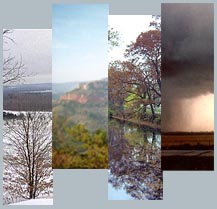Climate Variability and Change

Weather and climate extremes have motivated extensive research and monitoring activities to understand the risks to Illinois and surrounding regions. Climate variability can be thought of as variations of the atmosphere – earth surface system with time. Typically, climate variability considers changes over timescales of months to a few years. Climate change usually refers to a systematic change in the characteristics of the climate over time periods of decades or longer. Climate changes and variations are driven by natural forces like the sun and ocean conditions as well as human influences, such as greenhouse gas production and changes in the landscape (such as the shift from natural vegetation to corn and soybeans in the Midwest).
Our recent research in these areas has focused on such varied topics as drought, late spring freezes, the 1954 heat wave, the evaluation of state-wide extreme values, tornadic and non-tornadic wind fatalities, changing trends in Lake Michigan’s lake-effect snowfall, and causes of observed trends in rainfall extremes. A key goal is to foster better predictions and informed responses to extreme events, both on short- and long-term time scales where anthropogenic and natural forcing each play a major role. The Office of the State Climatologist is a program providing climate information and other services to the citizens and organizations of the Illinois and surrounding states.